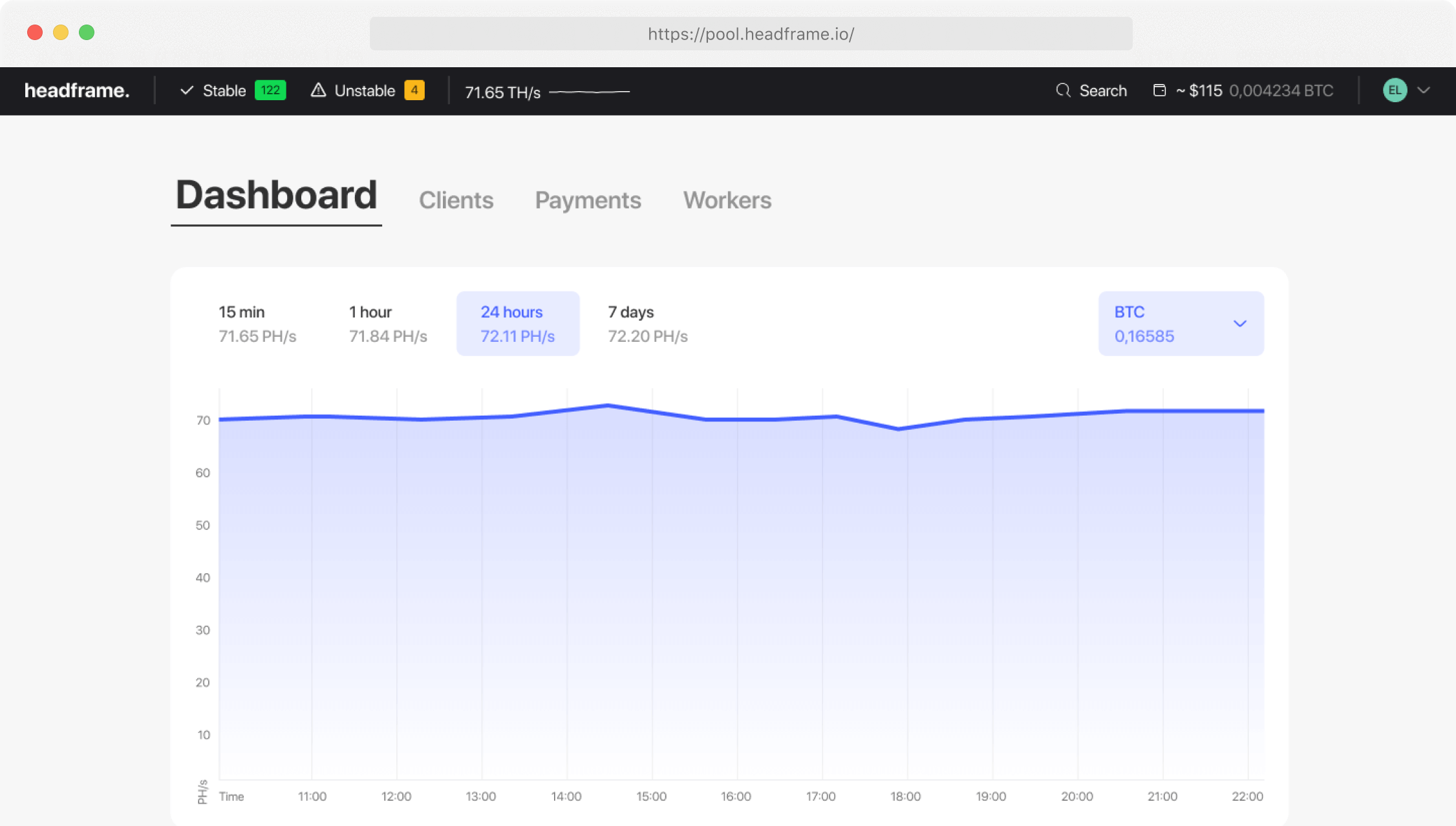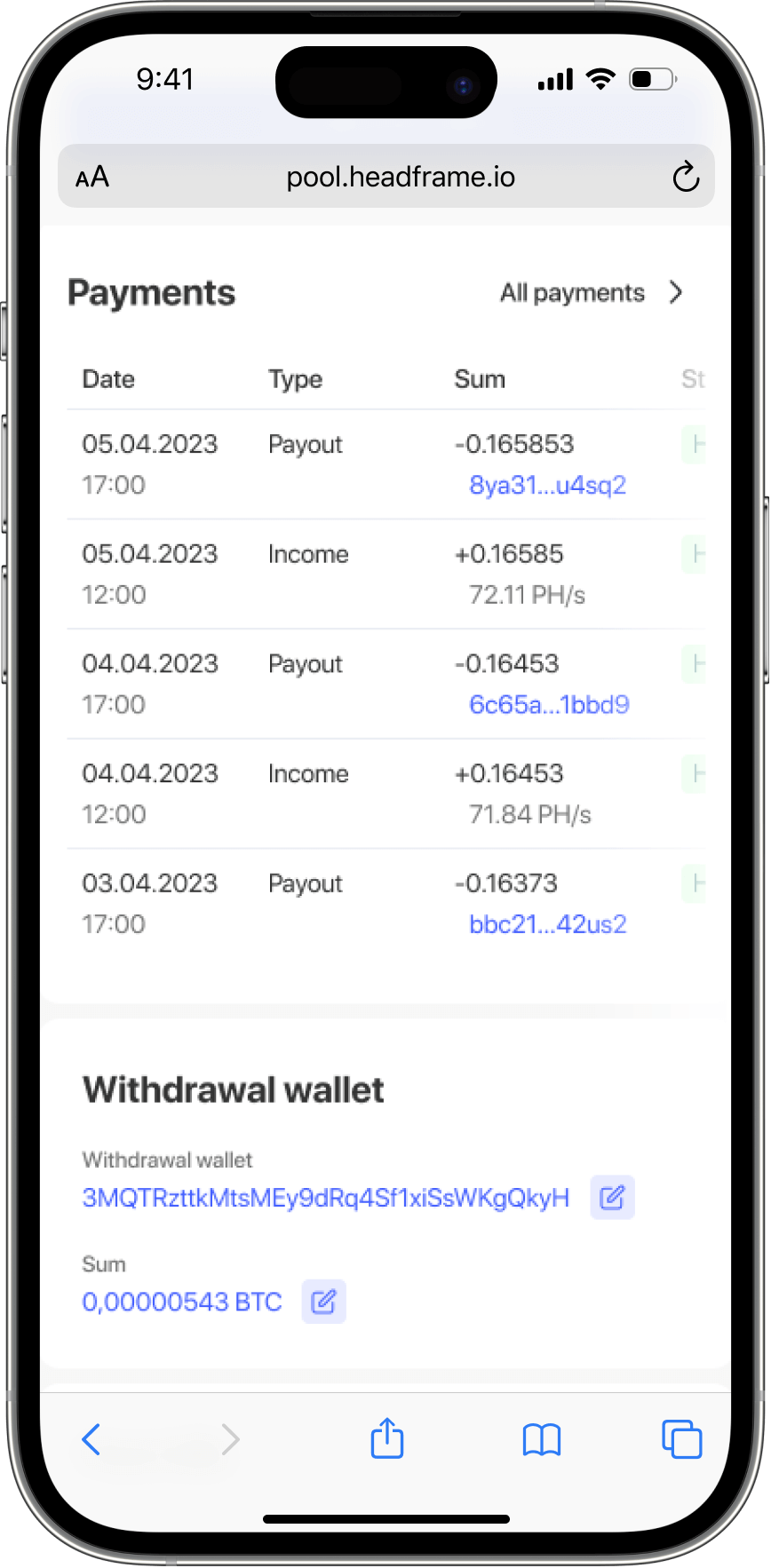
Bitcoin Hashrate: A Comprehensive Guide
This article covers the history and significance of bitcoin hashrate, including the relationship between mining difficulty and hashrate, the role of mining equipment and energy efficiency, and the importance of hashrate for network security and countering 51% attacks.
Earn more money with Headframe
Join a mining pool and get the best profitability in mining. Already more than 10,000 miners trust Headframe.
- What is Bitcoin hashrate?
- How is Bitcoin hashrate estimated?
- Relationship between Bitcoin mining difficulty and Bitcoin hashrate
- The importance of mining equipment and energy efficiency
- Bitcoin mining hashrate and mining difficulty prediction
- What does the 51% attack represent?
Bitcoin hashrate represents a key metric for the Bitcoin network, as it shows its current computing power. Roughly speaking, the overall Bitcoin hashrate shows how many times per second the mining hardware tries to find a new block in the Bitcoin blockchain. A higher hashrate indicates a higher number of attempts per second, making the Bitcoin blockchain generally more reliable. This article provides a detailed analysis of the Bitcoin hashrate, its characteristics, the factors that influence its changes, and its importance to mining and network security.
What is the Bitcoin hashrate?
In this section, let’s look at the basic concept of Bitcoin hashrate and how it works. Bitcoin hash rate is expressed in hashes per second (H/s) and represents the number of times a miner attempts to create a hash using the SHA-256 algorithm per second. Modern ASIC-based miners make trillions of such attempts every second in the hope of finding a hash that matches the current difficulty level. If the attempt is successful, the miner forms a new block, includes transactions in it, and transmits the information across the Bitcoin network. This action is rewarded with new bitcoins and transaction fees. To add a new block to the chain, the miner must find a hash that matches or is less than a given target value. Each such attempt is called a nonce, and each value is unique and only used once.
How is Bitcoin’s hashrate measured?
Just as disk space is measured in KB, MB, GB and so on, hashrate is determined through a number of metrics. Often miners simplify the hashrate metric by adding /s to it, which indicates the number of hashes created per second.
In the context of the cryptocurrency industry, hashrate plays a central role in measuring Bitcoin network performance. Currently, experts use units of measurement such as exahash (EH/s) to analyze the overall hashrate of the Bitcoin network and terahash (TH/s) when looking at individual mining devices. For smaller scale operations, it is common to use petahash (PH/s) as the unit of measurement.
To get the most accurate hashrate estimate, experts typically use an average over a 7-day period. This approach is due to the difficulty of measuring hashrate in real time, as there are many variables that can distort this indicator.
It should be emphasized that the importance of hashrate to the security of the Bitcoin network is paramount. A large hashrate ensures that the network is more resilient to various types of attacks, including potential 51% attacks.
Some of the main factors that affect hashrate include the current market value of Bitcoin. If the price of Bitcoin increases, there is an influx of miners into the network and a corresponding increase in hashrate. If the price decreases, unprofitable participants may cease operations, leading to a decrease in hashrate.
Past market trends have shown that price increases have facilitated the introduction of new technologies to optimize the mining process. For example, the advent of GPUs and ASIC devices has significantly increased the overall hash rate of the Bitcoin network.
The central criterion that determines the available amount of Bitcoin hashrate in the global market is the profitability of Bitcoin mining, or the potential revenue from the activity. This is measured using what is known as the hashprice, which gives an indication of the potential revenue from each unit hashrate.
The relationship between Bitcoin mining difficulty and its hashrate
Bitcoin mining difficulty represents the criterion that miners must achieve to validate the next block in the blockchain. According to the changes in the overall hashrate of the network, the Bitcoin protocol automatically modifies this figure every 2016 blocks, which is approximately two weeks. This adjustment mechanism ensures that blocks are added to the blockchain at an average interval of 10 minutes. If blocks are found faster, the difficulty increases; otherwise, it decreases. Given this dynamic, miners will need more or less hashrate depending on the current complexity.
Value of mining equipment and power efficiency
The quality and power of the mining equipment directly affects the hashrate a Bitcoin miner can provide. The more advanced the equipment, the higher the potential profit. However, it should be taken into account that high performance entails increased energy consumption, so efficiency in joules per terahash becomes an important parameter.
Early in Bitcoin’s history, mining was done using conventional processors (CPUs). However, in 2010, Laszlo Hanek introduced a mining method using graphics processing units (GPUs), which drastically impacted mining performance. By 2012, specialized integrated circuits (ASICs) were introduced to the industry, which again turned the idea of mining upside down. ASIC miners are currently the most preferred choice for professional Bitcoin mining.
Bitcoin mining hashrate and difficulty prediction
Since Bitcoin’s launch, its hashrate has increased exponentially, with mining complexity following the same trend. At the time of writing, the difficulty of mining a single block has increased by 48 trillion hashes since 2009, when the bitcoin mining era began. On average, the complexity has increased by 20.64% every month since launch.
The article also provides a detailed overview of the impact of bitcoin’s complexity on mining profitability and how to predict future changes. To dive deeper into the issue of mining profitability and complexity prediction, check out the Hashrate Index report below.
How the security of the Bitcoin network depends on its hashrate This section discusses the correlation between hashrate and the stability of the Bitcoin network, as well as the risks associated with a lower hashrate and the importance of its level in securing the network. In addition, the role of hashrate in countering double-spend attacks is discussed.
What is a 51% attack?
A 51% attack is a potential threat to proof-of-work blockchains when a single actor or coalition of miners controls more than 50% of the total hashrate. Such dominance provides an opportunity to disrupt the stable operation of the network by affecting the order of transactions and block mining.
How does bitcoin hashrate protect against a 51% attack? It should be taken into account that the realization of a 51% attack is a labor-intensive and financially costly process. Such an action requires huge computing resources and energy comparable to the consumption of a small European country, such as Austria or Greece. In addition, the attacker will be competing with loyal miners, which increases its block mining costs. In the case of a successful block reorganization, the energy costs increase proportionally to the number of blocks to roll back. Such an attack is likely to cause anxiety in the community, which could lead to a loss of trust in bitcoin, a decrease in its price, and thus a decrease in the attacker’s profits. Based on this, a 51% attack is unprofitable and unlikely for most miners.
This explains why proof-of-work is an important element of bitcoin security. The bitcoin mining system rewards miners for their contributions (in the form of block rewards and transaction fees) while compensating them for their costs (such as electricity). The balance between rewards and costs makes an attack on the bitcoin blockchain uneconomical.


